
We are bivouacked on the 24th floor of a downtown Birmingham hotel. I do not know how or why we got here, and I’ll leave it at that.
Today was a driving day. St. Andrew’s looks different without the fog.


We saw some Roman ruins along Hadrian’s Wall.
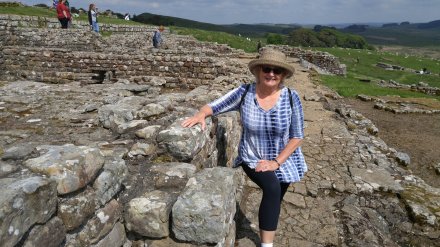

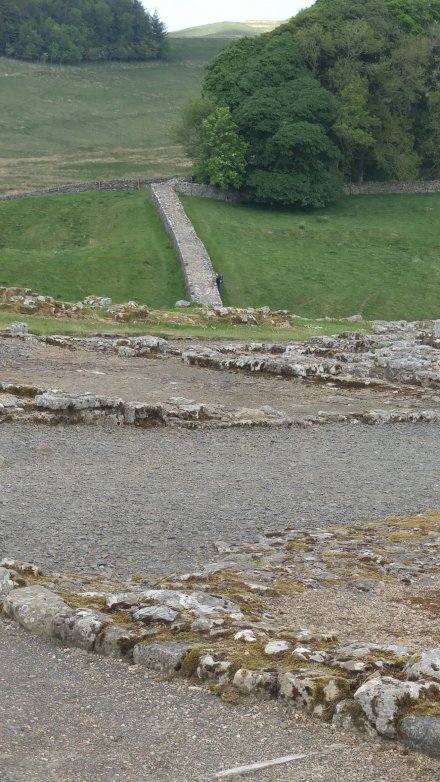


We are bivouacked on the 24th floor of a downtown Birmingham hotel. I do not know how or why we got here, and I’ll leave it at that.
Today was a driving day. St. Andrew’s looks different without the fog.


We saw some Roman ruins along Hadrian’s Wall.





Turns out there’s more to St. Andrew’s than a golf course.

For instance, St. Andrew’s University is the oldest University in Scotland. It’s pretty interestingly laid out, with University buildings intermingled with the other buildings of the town.

And there are some interesting ruins, especially a cathedral and a castle.

The waterfront is probably pretty unusual, but the fog was getting thick by the time our late-day walk got us to the shore.


But yes, there is a golf course, the Old Course, the birthplace of golf, and on Sundays they don’t play golf on it – they open it up to the public to take a good walk without having it spoiled.



And that’s what we did.
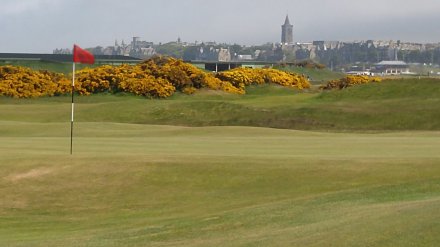
Compare that to our experience at the car rental office this morning, where we stood in queue for over an hour before we finally got our car, and then through a series of missed turns took a half hour to drive the mile back to our flat to check out.
And then, it turns out to be a major three-day weekend holiday here in Britain, and we were turned away by our first restaurant for want of a reservation.
Fortune smiled on us at our next try, Forgan’s, where the manager squeezed us in, and we had a delightful meal.
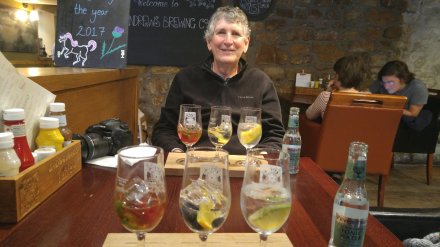
Finished off the day with gin flights at the St. Andrews Brewing Company

This post will be short on narrative and long on photos.
This morning we went to the bottom of the hill below the castle, climbed a steep path up the cliffs to the castle, and were turned away at the top due to construction.
But we made it around to the entrance, toured the castle, and walked down the Royal Mile.
We visited parliament, climbed a big gorse-covered extinct volcano, and finally found our way back to our flat.






Margaret’s Chapel, oldest building in Edinburgh

Inspiration for Raleigh’s iconic acorn?

Changing of the guard at Edinburgh Castle






Crashed a tour lecture in Parliament


Gorse-covered mountain






Monument to cousin Bobby Burns

No, really. Rebecca is a Vermeer birder, and her eyes lit up when she saw the Scottish National Gallery has a Vermeer.
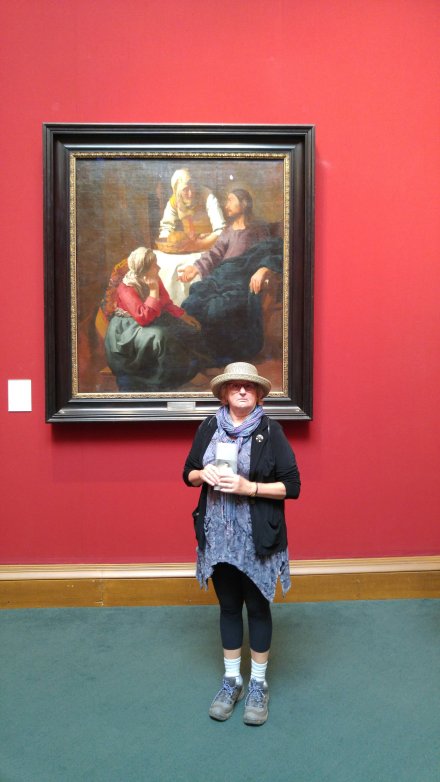
Imagine her surprise when the Vermeer was full-size. It is the largest known Vermeer. Also of note were a couple of Rembrandts, a Leonardo, and some really cool Cezannes.

Jewelry for a witch. This necklace was used to encourage women to confess they were witches.
Our other museum of the day was the National Museum, a really fun museum filled with a lot of animal remains, a bunch of machinery, a nice history of Scotland, a wing of women’s clothes, and a bunch of interactive displays for the kiddie in you.

The outside of the museum is a typical Edinburgh block stone facade, but the inside is a Victorian dollhouse, with some modern wings. I think I heard it was Prince Albert’s last project.

Sculpture of St. Andrew toting his cross, which became the Scottish flag.
We finished the day with a literary pub crawl, where a couple of thespians talked about Scottish writers and the dichotomy of Edinburgh. Cousin Bobby Burns was prominent, but Robert Lewis Stevenson’ s Dr. Jekyll and Mr. Hyde (apparently it’s pronounced Jeekle) is the more apt metaphor for Edinburgh.

Maintaining a theme, we started our pub tour at The Beehive. Those of you with short memories might not recall the Beehive at the Dingle Peninsula. More obscure is a hike at Acadia N.P. known as the Beehive, which is archived somewhere.

Remember that scene from Raiders of the Lost Ark, when he backs his assailant into a plane’s propeller?
That’s a prop out the airplane window. When was the last time you flew in a commercial airliner driven by propellers? Boats, sure, but a plane?
We drove from Cork to Dublin, then flew to Edinburgh.

Edinburgh Castle. You’ll see a lot more of this tomorrow.
Not a lot else to say.

The view from our flat. Rebecca did it again.

The harbor at Cobh, just downstream from Cork, is the second largest natural harbor in the world.
It is the only port in Ireland where cruise ships can actually dock adjacent to land.
Cobh, back when it was known as Queenstown, was the last port of call for the Titanic, and the rescue port for the survivors of the Lusitania.

Irish acrobatics in Cobh.
The port was a major embarcation point for hundreds of thousands of starving Irish folks who fled Ireland in the second half of the nineteenth century as a result of the potato famine.
The name Cobh was given to the town because it’s more or less phonetically pronounced “cove,” and it looks Irish.
We took a quick train ride from Cork to Cobh this morning.

Cobh has just as big a hill to climb at the water’s edge as does Cork. There is one huge church partway up the hill in Cobh, made all the more imposing by the way it towers over the waterfront.
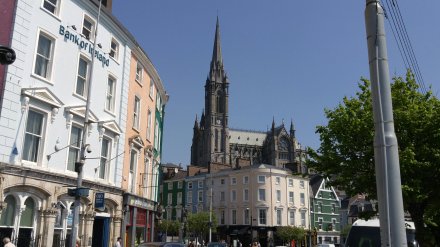
While we were on the train Rebecca told me to take more pictures.
More pictures, fewer words.

John Kennedy Garden

Political activism in front of the Lusitania Memorial



View of castle from train.

View of Bunky on the train.

Back in Cork, we found the English Market, the last item on our scavenger hunt list.

This guy could really play the fiddle.
It turns out Cork may be the best place to hear traditional Irish music.
First impressions of Ireland’s second largest city were a bit misplaced. After a run of small towns, Cork has the makings of a big city.
Our hotel is about a mile from the city centre, and the return trip is all uphill. Steeply.

The first issue was that the Tourist Information Center was not where it was supposed to be. The corner across the Lee River via the St. Patrick’s Bridge was under construction. Fortunately a kind stranger looked it up on his phone and gave us alternate directions.
At the center we learned the opening of the new center, identified on the tourist maps, was delayed. We had a good laugh over it, and got some maps for self-guided tours. There were supposed to be informational posters at key points of interest along the route, which were not immediately obvious.

It turned into something of a scavenger hunt, which added an element of fun and helped to break the ice.
In addition to the modernish buildings and whizzing cars, Cork has a fascinating maze of pedestrian-only streets, and two forks of the river surrounding the city centre.
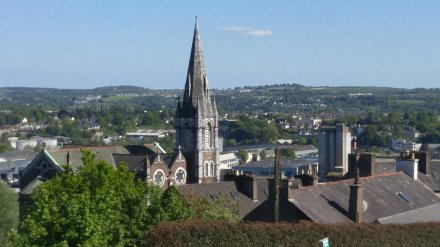
The view out our hotel room window.
At night the bustle of the city dies back, and a pleasant, vibrant nightlife emerges.
And one easily finds numerous pubs featuring extremely high-quality music.

One such pub offered a lengthy menu of Irish, and not-so-Irish, whiskeys. It took them about twenty minutes to find the bottles of the two Irish whiskeys I ordered.
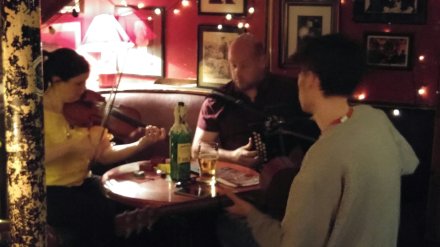
The day had begun in Killarney, where we embarked on the national park stretch of the Ring (in this case the Arc) of Kerry.

It was a beautiful drive through the mountains of Killarney National Park.

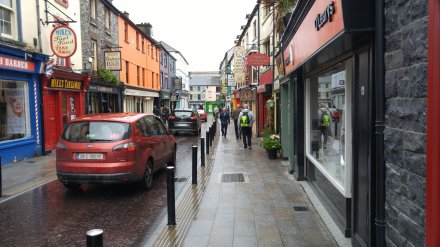
Today it rained enough to make for a good day to hang around town shopping. It did not rain as much as predicted, and in fact as soon as I bought an umbrella the rain slacked off enough for me not to need one.
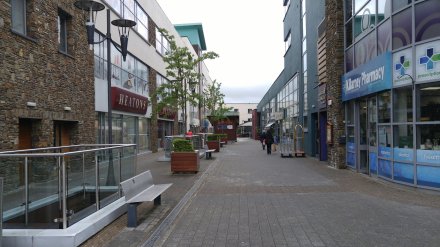
A less charming section of Killarney.
We were walking along the street when the familiar strains of “Wagon Wheel” emanated from a bar (recorded, not live).

St. Mary’s looms behind St. Rebecca.
We visited a couple of churches, one of which is a giant stone cathedral, St. Mary’s. Construction on the cathedral, begun in the 1840’s, took over 70 years to complete.

Well before it was completed, it was consecretated on Filbert Hockey Day (the Feast of St. Philibert).
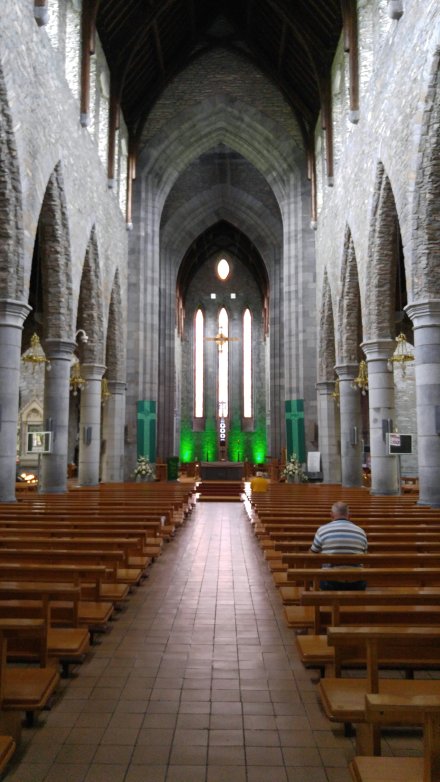
Inside the cathedral.

The altar of the Franciscan Friary.
We also found some more live music. The ensemble this time was interesting and a good bit different: mandolin, harp and hornpipe.


the longer we’ll stay together.
If you’ve never hiked with Rebecca, you might not understand this country song.
Anyway, today we had a short drive to Killarney. Believing the weather forecast, we opted for walking to Killarney National Park rather than biking.

We found our way to the park via a road that passed a Ross Golf Course. I thought maybe it was a Donald Ross design, but it was named after the castle.

The park is the first national park in Ireland. It is noted for three big lakes, mountains, bogs, old trees and red deer. We didn’t make it to the mountains, but we did slog through some boggyness.

Rare red deer
A long walk later we found our way back to town, where we found an Irish pub (imagine that).

I have a new favorite sport: Hurling. Hurling is like lacrosse rugby. The players wear helmets and no other armor. They run around with a large wooden spoon and crash into each other a lot.

The most amazing aspect is they will be running with the sliotar (a ball that looks like a baseball), then they’ll toss it up and smack it with their spoon for more than three hundred feet, as often as not through a football-looking goalpost for a point. There’s a soccer goal-looking target worth three points, but I did not see one scored (watching on the tele).
Bonus coverage:. Here’s a view of the Murphy Pub from the Dingle Docks.

Murphy Pub is the cream-colored one.

Today’s drive from Miltown Malbay was relatively easy. For most of the coastal route we passed through cow country, with wider, flatter, uncrowded roads.
We even shaved a long chunk of roadway by taking the ferry across the Shannon estuary.


Funny thing about Ireland. Most of the inland is gently rolling hills at the extreme, but when you get to the west coast it’s quite mountainous. The last leg of our day’s journey took us through the Conor Pass.
Signs at the foot of the mountain warned trucks and campers to find another way across. For most of the adventure up to the 1500-foot-high pass, the highest in Ireland, the going was not too difficult. All the bicyclists were going down.

Irish waterfall approaching Conor Pass
Then we came to the last switchback, maybe a kilometer below the road’s summit, and it narrowed to a single lane. The last stretch was hewn from a sheer rock face. Think Going to the Sun Road, but one skinny lane.
We met one car coming down toward us, forcing us to back up a few dozen curvey feet until we could snuggle up against the rock side. Just before the top we encountered another, who fortunately backed out of our way.
It’s the second scariest road I’ve ever driven, bested only by a gravel road that switch-backed 1000 feet up the sheer face of a Utah mesa, with no guard rails. Even that Utah ascent accommodated two-way traffic.
When we arrived at Murphy’s Pub in Dingle, we were told they did not have our reservation. Fortunately they were concerned rather than dismissive, and eventually we ascertained that the reservation with no associated name was ours, and we checked in.
For the remainder of the afternoon we got back into the car and explored the Dingle Peninsula by way of the Slea Head Drive. Another narrow coast-hugging road bordered by mountains, Slea Head Drive offers beautiful scenery along with several ancient stone building sites.

Rebecca in the Beehive
I found the “Beehive” complex to be especially fascinating.

Sheep within ancient rock walls.
Tonight there is live music here at Murphy’s, so the odds are good we will finally hear some native sounds. Intriguingly, we’re told fiddle music is hard to come by around here.
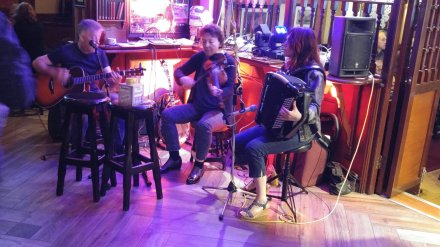
Yes we did. One of three bands we saw, and we even found a fiddler.